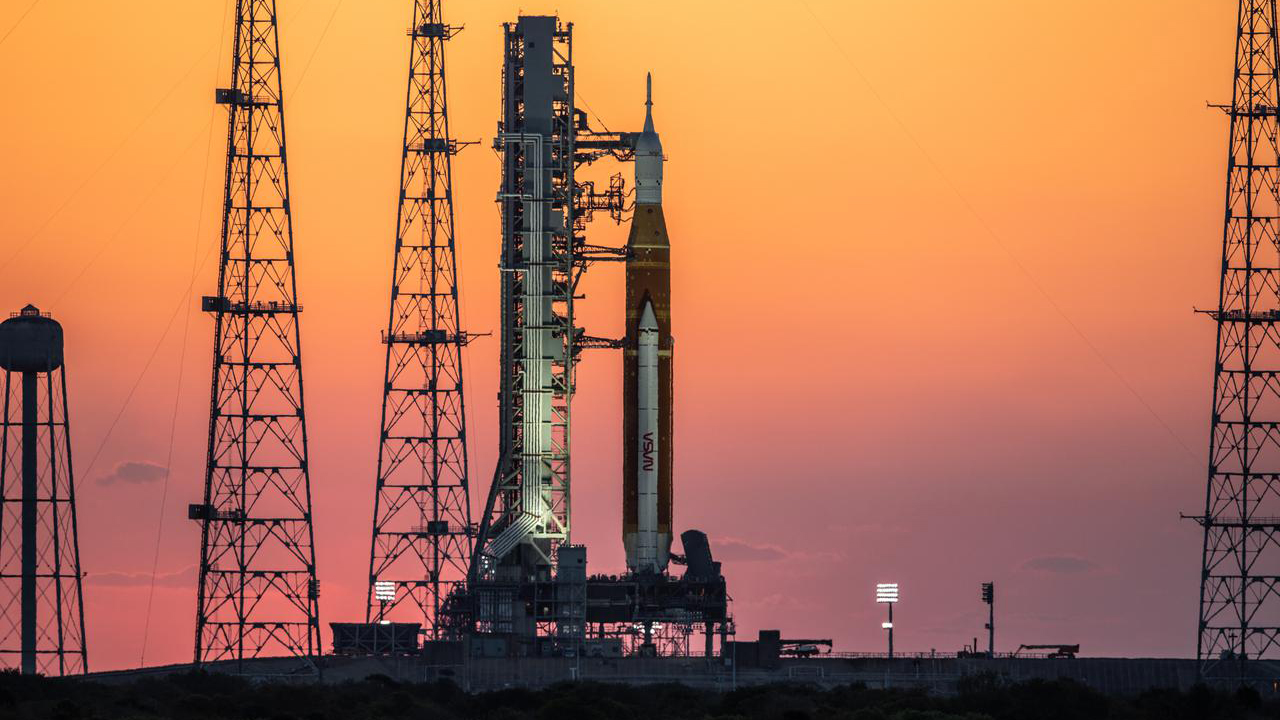Why was NASA's 'Mega Moon Rocket' test delayed (again)?
Liftoff could be delayed until August at the earliest.

NASA’s huge "Mega Moon rocket" is being removed from its launchpad and sent for repairs after failing three fuel tests in two weeks. Following the failures, NASA has said that the rocket’s slated June launch window will be "challenging" to meet.
The space agency has been running various prelaunch tests on the rocket, officially known as the Space Launch System (SLS), since April 1, two weeks after it was brought out to Pad 39B at NASA's Kennedy Space Center (KSC) in Florida. NASA hoped that the tests, known as the "wet dress rehearsal," would take less than 48 hours to complete, but two weeks and three trials later, the agency has decided to bring the 322-foot-tall (98 meters) rocket back inside.
The wet dress rehearsals were being performed to ready the world’s most powerful rocket for the upcoming Artemis I flight, which will see the SLS fire an uncrewed Orion capsule around the moon and back in preparation for later crewed missions. But after the colossal rocket inched its way out onto the launchpad, NASA engineers’ attempts to load it with propellant and prepare it to the point of ignition failed. NASA has identified the main problems as a faulty helium check valve and a liquid hydrogen leak and hopes to remedy the issues through improvements to both the supply systems and the rocket, the agency said in a statement.
Related: NASA prepares 'moonikin' for spaceflight aboard 1st Artemis mission
The agency insists that, aside from these "nuisance" issues, the rocket is fine.
"The Mega Moon rocket is still doing very well. The one check valve is literally the only real issue we’ve seen so far. We’re very proud of the rocket," Tom Whitmeyer, a deputy associate administrator at NASA headquarters in Washington, D.C., said at a press conference on Monday (April 18). "But we have a little bit more work in front of us."
NASA engineers expect to roll the rocket back inside the Vehicle Assembly Building by April 26, where they will replace a defective helium check valve on the rocket’s upper stage that prevented ground crews from loading it with supercooled liquid oxygen and liquid hydrogen.
Sign up for the Live Science daily newsletter now
Get the world’s most fascinating discoveries delivered straight to your inbox.
Work on the rocket is expected to take most of May to complete. The time needed to perform these repairs will open a window for NASA’s gaseous nitrogen supplier, Air Liquide, to upgrade its off-site systems, and for the space agency to fix a leak on the the mobile launch tower's tail service mast umbilical, which feeds the rocket propellant and electricity while it is on the launchpad. The repairs will also give NASA engineers time to review the results of the failed wet dress attempts, reappraise the test schedule and decide on any further checks to make before attempting launch.
Following these delays, it is currently unclear when Artemis I will launch. No date has been set for the next wet dress attempt, but if May is taken up by repairs, it's possible that the next opportunity could be in June. NASA would then need to take the rocket back to the assembly building yet again to activate its flight-safety system before returning it once more to the launchpad. (The trip to the launchpad alone takes more than 10 hours.) All of this considered, the rocket’s liftoff could be delayed until August at the very earliest.
But despite the setbacks, NASA is confident that the moon rocket, which is more than 11 years and $30 billion in the making, will be ready soon.
"We'll absolutely go back out [to the launchpad]. We're absolutely going to do a wet dress rehearsal," Whitmeyer said. "It's just a matter of what's the right time, what's the right way to do that."
Once the rocket finally lifts off for its inaugural mission, it will embark on a 280,000-mile (450,000-kilometer) round trip around the moon, going farther than any spacecraft built to carry humans has ever gone before, according to NASA. Artemis I will then be followed by Artemis II, which will make the same flyby but with human passengers, and Artemis III, which will send humans back to the moon’s surface — including the first woman and the first person of color.
Originally published on Live Science.

Ben Turner is a U.K. based staff writer at Live Science. He covers physics and astronomy, among other topics like tech and climate change. He graduated from University College London with a degree in particle physics before training as a journalist. When he's not writing, Ben enjoys reading literature, playing the guitar and embarrassing himself with chess.









